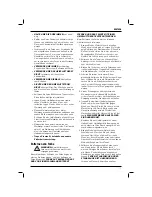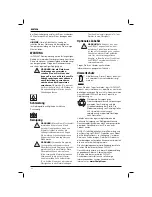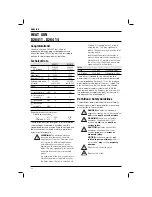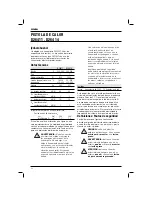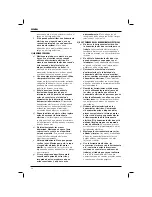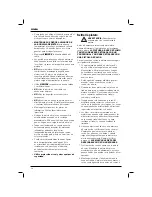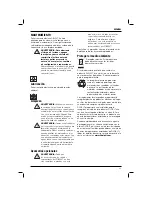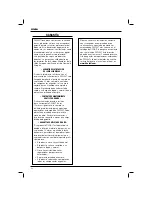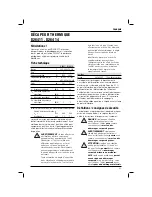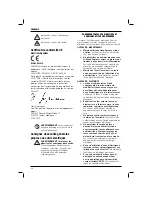
ENGLISH
31
Switching On and Off (fi g. 4)
1. Push the on/off switch (a) to the desired air flow
settings:
I: 240 liter/min (50ºC–400ºC)
250 liter/min (50˚–400˚C)] (D26414)
A low air flow to heat up the workpiece
slowly.
II: 450 liter/min (50˚–600˚C)
500 liter/min (50˚–600˚C) (D26414)
A high air flow to heat up the workpiece
quickly.
2.
To turn the tool off, push the on/off switch (a)
to position O. Disconnect the tool from the
power source and let the tool cool down before
moving or storing it.
Removing Paint
WARNING:
Refer to
Important Notice
under
Additional Safety Instructions
for Heat Guns
before using the tool to
remove paint.
WARNING:
Do not strip metal window
frames as the heat may crack the glass.
•
When striping other window frames, use a
glass protection nozzle.
•
To prevent igniting the surface, do not keep
the tool directed at one spot too long.
•
Avoid collecting paint on the scraper
accessory, as it may ignite. If necessary,
carefully remove paint debris from the
scraper accessory using a knife.
1. Attach the appropriate accessory.
2. Turn the air temperature adjustment knob (d) to
high.
3. Turn the tool on by selecting the desired air flow.
4. Direct the hot air onto the paint to be removed.
Best results will be achieved if the heat gun is
moved slowly, but CONSTANTLY, from side to
side to evenly distribute heat. DO NOT LINGER
OR PAUSE IN ONE SPOT.
5. When the paint softens, scrape the paint away
using a hand scraper.
REMEMBER:
Splinters and small particles of
stripped paint can be ignited and blown through
holes and cracks in the surface being stripped.
Stationary Use (fi g. 1)
This tool can also be used in stationary mode.
1.
Fold down the kickstand (c) as shown in
Figure 1.
2. Set the tool onto a level, stable workbench.
Ensure the tool will not tip over.
3.
Secure the power cord to prevent entanglement
or pulling the tool off the workbench.
4. Turn the tool on by selecting the desired air flow.
Constant Heat Control
(Overload Protection)
When the tool is overloaded, this feature protects
the heating element from damage without stopping
the tool and/or without a cool down period.
1. When the temperature gets too hot, the heating
element switches itself off. The motor will
continue to run and produce cold air.
2. When the temperature has cooled sufficiently
(taking only a few seconds) the heating element
will switch on automatically.
Tool Ring (fi g. 1)
WARNING: ALWAYS
turn heat gun off,
disconnect from the power source and
let the tool cool down for at least 30
minutes before moving or storing it.
For easy storage, the tool can hang from the tool
ring (f). The heat gun should be stored indoors.
Cool Down Period
The nozzle and accessory becomes very hot during
use. Turn heat gun off, disconnect from the power
source and let the tool cool down for at least 30
minutes before moving or storing it.
NOTE:
To reduce the cooling time, switch the tool
on at the lowest air temperature setting and let it run
for a few minutes before turning the heat gun off.
MAINTENANCE
Your D
E
WALT power tool has been designed to
operate over a long period of time with a minimum
of maintenance. Continuous satisfactory operation
depends upon proper tool care and regular cleaning.
WARNING: To reduce the risk of
injury, turn unit off and disconnect
machine from power source before
installing and removing accessories,
before adjusting or changing
set-ups or when making repairs.
Be sure the trigger switch is in the OFF
position. An accidental start-up can
cause injury.
Summary of Contents for D26411
Page 1: ...www eu D26411 D26414 ...
Page 3: ...1 Figure 1 a c b d e f g D26411 a c b d e f g D26414 h d ...
Page 4: ...2 Figure 2 Figure 3 Figure 4 A ...
Page 145: ...143 ...
Page 146: ...144 ...
Page 147: ...145 ...

